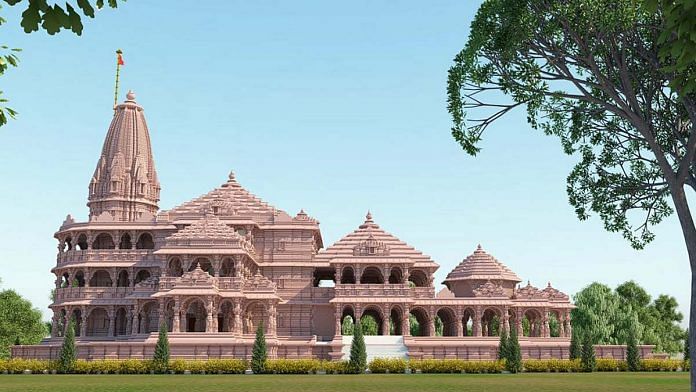The consecration ceremony of Ram by Prime Minister Narendra Modi was a grand gesture announcing the beginning of a Ram Rajya in India. And as all his political spectacles go, this one too was laden with symbolism—an olive branch to South India, where the Bharatiya Janata Party’s forceful track record runs dry.
Look beyond the realisation of the BJP’s largest ideological project and what it means for the future of India. One of the immediate political messages just might be for the South.
The ceremony highlighted cultural differences, and a conscious attempt to include South Indian symbols. It’s a marked departure from North Indian temples.
The idol at Ram Mandir is made of black stone and wears a thenkalai namam (u-shaped forehead ornament) , much like the Tirupati Balaji temple idol. The nadaswaram — a distinctly South Indian sound — played in the background, while the idol was adorned with huge garlands with all kinds of flowers and not just the North Indian-preferred marigold.
Of course, this inference also oversimplifies South India as a monolith when it is very much an amalgamation of distinct cultural styles, each with its unique pride. However, the attempt to do so at the Ram temple begs a larger question: What does it serve?
Also read: Ayodhya Ram temple a political game-changer for Modi, BJP? Pew survey on religion has answers
The North-South divide
Modi has been traversing the South, trying to straddle the breadth of ‘Indian’ religiosity. His pilgrimage stops were meant to retrace Ram’s mythological steps, but they also included comparatively smaller temples such as the popular Nalambalam Shri Ramaswamy temple in Kerala’s Thriprayar. The rest of his itinerary included stops like Sri Venkateswara Swami temple in Tirumala and the Veerabhadra temple in Lepakshi, Andhra Pradesh, where he listened to Telugu hymns about Ram. He rounded off his trip in Tamil Nadu’s Rameswaram, before travelling back to Ayodhya for the consecration ceremony.
And this is following the inauguration of the Kashi Tamil Sangamam in December 2023. The Sangamam celebrates the historical ties between Kashi and Tamil Nadu and is clearly an important project for Modi as he tries to make inroads in the South.
However, there are also whispers about whether the Ram temple will have the same hold over the South Indian Hindu imagination, especially in a largely Shaivite Tamil Nadu.
So far, the BJP has engaged in bitter arguments with political rivals in the South like the Congress, Dravida Munnetra Kazhagam (DMK), and the Left Democratic Front (LDF). But now it seems like the Ram temple is trying to widen its cultural lasso to appeal to — or appease — an India beyond the cow belt.
Also read: For 500 years, Ayodhya was ‘Shriheen’. Now, it’s all aglow
A deliberate ‘integration’
The Ram temple is built in the North Indian Nagara style, replete with ostentatious grandiosity. But there are some deliberate nods to South Indian sensibilities.
The idol itself was made by fifth-generation sculptor Arun Yogiraj, who is from Mysuru. Some of his most famous works include a black granite sculpture of Subash Chandra Bose (at New Delhi’s India Gate) and a 15-foot-tall sculpture of BR Ambedkar. His grandfather, B Basavanna Shilpi, was patronised by the kings of Mysore and was known for creating 64 idols in less than a year for a temple located on Mysore Palace grounds.
Yogiraj’s 51-inch idol of Ram is made of Krishna Shila stone sourced from Kote in the Mysuru district. The stone is unique because it doesn’t react to any liquids, and has reportedly been used in temples in Karnataka for the last thousand years. As part of his research, Yogiraj visited schools in Mysuru to collect references to visualise the idol as a child.
Most of the doors within the Ram temple complex were made by a South Indian firm, contributing to the selection of artisans from across India. Despite being built in the North Indian Nagara style, the Hyderabad-based Anuradha Timbers built over 18 doors and 100 door frames for the complex and reportedly employed skilled artisans from Tamil Nadu.
Besides the idol, all these leitmotifs are subtle notes from the South. It remains to be seen if this political messaging will reach its intended audience.
Views are personal.
(Edited by Ratan Priya)



